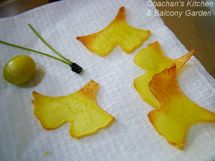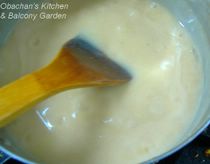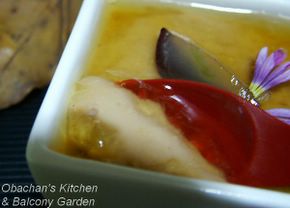1.秋の前菜盛合せ Autumn Plate 鶏肉柚子醤油焼き、きのこ肉詰め焼き、かまぼこ紅葉七味風味、そうめん松葉、いくら醤油漬、銀杏、銀杏芋 Broiled chicken marinated in yuzu-soy sauce, Mushroom meat balls, Maple-leaf shaped kamaboko (steamed fish cake) with shichimi pepper, Somen noodle pine leaves, Salmon roe, Ginkgo nuts, Ginkgo sweet potato *  Broiled chicken: This was not a great success. The yuzu aroma faded pretty quickly and left the chicken rather bland. Broiled chicken: This was not a great success. The yuzu aroma faded pretty quickly and left the chicken rather bland.Mushroom meat balls: Aren’t they cute, looking like sawtooth oak acorns? The bottom parts are big Shimeji mushrooms. I didn’t expect the mushrooms to open up like this, but I think it’s cute. Maple-leaf shaped kamaboko: This is something that I whipped up. I sliced white kamaboko, brushed the surface with mirin & soy sauce mixture and burned it over the open flame of a stove top. Then I brushed the sauce again and sprinkled shichimi pepper. I wanted to brown the surface a little more, but I was worried about the shichimi pepper coming off, so I just punched the kamaboko with a maple-leaf shaped mold. *  Somen noodle pine leaves: This was so much fun to make! :D All you have to do is to break somen noodles into 5 or 6 cm lenghths, pick two, seal one end with tempura batter (I wrapped that part with dried seaweed) and deep-fry. The somen pine leaves will sink into the oil and immediately come up to the surface, slightly curved like real pine leaves. And they are done. Perhaps the only challenge would be finding green colored somen noodles. I shopped around quite a bit until I finally found a brand of somen noodles which had a couple of pink and green noodles in each bunch like this. I guess it is meant to add a little color to the noodle dish. Somen noodle pine leaves: This was so much fun to make! :D All you have to do is to break somen noodles into 5 or 6 cm lenghths, pick two, seal one end with tempura batter (I wrapped that part with dried seaweed) and deep-fry. The somen pine leaves will sink into the oil and immediately come up to the surface, slightly curved like real pine leaves. And they are done. Perhaps the only challenge would be finding green colored somen noodles. I shopped around quite a bit until I finally found a brand of somen noodles which had a couple of pink and green noodles in each bunch like this. I guess it is meant to add a little color to the noodle dish.Salmon roe in sudachi citrus cup: I’ve seen this in so many photos of traditional Japanese course meals, and I’ve always wanted to give it a try. The salmon roe seasoned with soy sauce was store-bought, but I did make this sudachi cup. Not bad, ha? Oh, wondering why these fish eggs have anything to do with autumn theme? Well, salmon lay eggs in autumn. ;) Ginkgo nuts with salt: This year I didn't pop the nuts in microwave like I did last year so that I won't scare the neighbors -- hahaha. I cracked and removed the shells with pliers and microwaved the nuts for about 20 seconds. I did another trick with the salt to make it very fine and dry -- I microwaved it and then ground it with mortar and pestle. I saw the head chef doing this once in a while at the kaiseki place where I work at. The other chef told me that it makes the salt dry and fine. He said that tasty, “authentic” salt is usually quite moist, but with this trick, it becomes suitable for sprinkling or dusting.  Ginkgo sweet potato: I got this idea from Mr. Murata’s Kaiseki book. My ginkgo sweet potatoes were not soaked in yellow coloring water as mentioned in the recipe in the book, but still looked yellow enough – at least when sitting on white paper. Ginkgo sweet potato: I got this idea from Mr. Murata’s Kaiseki book. My ginkgo sweet potatoes were not soaked in yellow coloring water as mentioned in the recipe in the book, but still looked yellow enough – at least when sitting on white paper.2.胡桃豆腐 Walnut Tofu 胡桃豆腐 Kurumi dofu Walnut Tofu  This was definitely a big -- or reckless -- challenge for me; I tried out the walnut tofu recipe in Mr. Murata’s book. It wasn’t a great success, as expected, but it wasn’t a crash and burn disaster, either. My walnut tofu didn’t set firm enough to be cut in a cube (I think I added wrong amount of kuzu starch) so I served it in this tiny cup. And I didn’t have the walnut oil which was called for in the recipe. So, what I made was probably very far from what it was supposed to be. I hope kaiseki chefs do not get mad at me for disgracing a famous chef's recipe... :P This was definitely a big -- or reckless -- challenge for me; I tried out the walnut tofu recipe in Mr. Murata’s book. It wasn’t a great success, as expected, but it wasn’t a crash and burn disaster, either. My walnut tofu didn’t set firm enough to be cut in a cube (I think I added wrong amount of kuzu starch) so I served it in this tiny cup. And I didn’t have the walnut oil which was called for in the recipe. So, what I made was probably very far from what it was supposed to be. I hope kaiseki chefs do not get mad at me for disgracing a famous chef's recipe... :PBut one thing is sure: trying out this recipe introduced me to a new combination of tastes that I didn't know before. This walnut tofu IS a delicacy. Indeed, grating sesame seeds and walnuts with a mortar and pestle was some work, but I understand that it had to be done that way.  You can’t use store-bought sesame paste for this dish. And you MUST use good dashi broth taken from kelp and bonito flakes. Taking an easy way out would make a huge difference in the delicate taste of this dish. You can’t use store-bought sesame paste for this dish. And you MUST use good dashi broth taken from kelp and bonito flakes. Taking an easy way out would make a huge difference in the delicate taste of this dish.BTW, the black thing on top of my walnut tofu is a quartered piece of a grape. The walnut tofu in the kaiseki book was garnished with a few small grapes, so I wanted to do the same. But only bigger grapes were available at nearby supermarkets, and one whole grape was too big for my tiny tofu, so I quartered it. I left the skin on so that the grape would stand out on the dashi jelly poured over the tofu. Dashi-jelly and grape. What a combination! I’ve never thought about tasting those two together, but the combination was amazingly refreshing. Mmmmm.... My compliments to the person who invented this combination.  Categories: Japanese |
Wednesday, November 22, 2006
先付 二種 Sakizuke nishu (Two Kinds of Appetizers)
Posted by
obachan
at
11/22/2006 10:18:00 AM
![]()
Subscribe to:
Post Comments (Atom)




















1 comments:
the walnut tofu sounds awesome!!
i hope i'll be able to find the recipe on the net somewhere...
Post a Comment